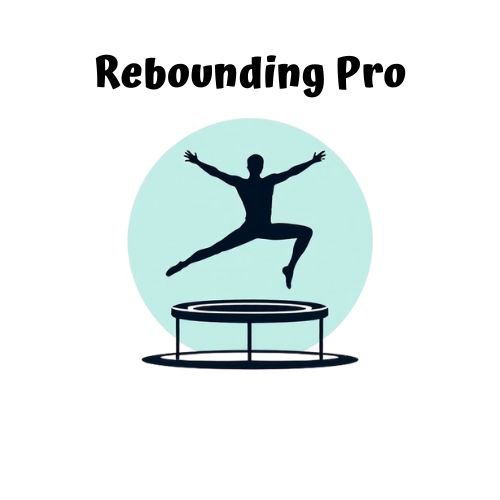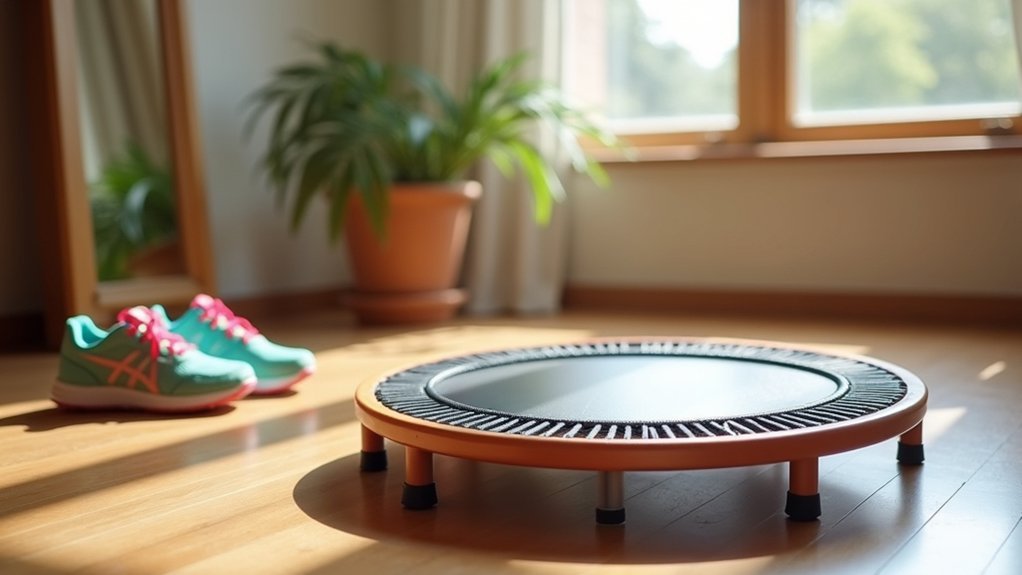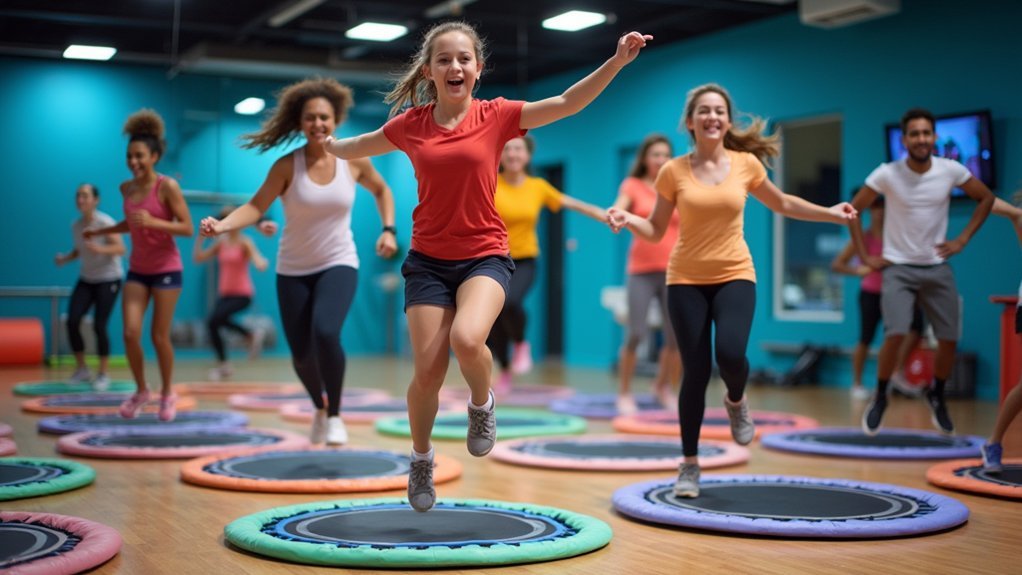For osteoarthritis relief, try these five low-impact rebounding moves: gentle health bounces with feet flat on the trampoline, controlled side-to-side movements for hip stability, seated bounces for limited mobility, stationary marching to engage your core, and gentle arm movements while maintaining a stable stance. Always keep your knees slightly bent and maintain proper alignment with feet hip-width apart. The combination of these gentle techniques can markedly reduce joint pain while building supportive muscles around affected areas.
Gentle Bouncing Techniques to Reduce Joint Stress

While many people with osteoarthritis avoid exercise for fear of worsening their symptoms, gentle bouncing offers a surprisingly effective way to manage joint pain.
Techniques like rebounder therapy provide low-impact movement that actually helps lubricate your joints and reduce inflammation.
Rebounder therapy creates gentle motion that bathes joints in lubricating fluid while naturally reducing inflammation.
You’ll find that regular gentle bouncing strengthens the muscles supporting your affected joints, improving stability without the harsh impact of traditional exercises.
The controlled bouncing motion enhances your range of motion and decreases stiffness over time.
Before you begin, always consult your healthcare provider, especially if you’ve had joint surgery.
Start with balanced, smooth movements using supportive equipment if needed.
It’s important to remember that bouncing should be avoided as a stretching technique since it can lead to injuries, particularly in already sensitive joints.
When combined with other therapies like heat treatment or tai chi, these bouncing exercises become part of a thorough approach to managing your osteoarthritis symptoms.
Balance-Building Rebounding Moves for Knee Support
Building on the gentle bouncing techniques, let’s focus specifically on enhancing knee stability through targeted rebounding exercises.
You’ll want to maintain proper alignment with feet hip-width apart and knees tracking over your middle toes while performing these balance-building moves.
- Practice the health bounce by keeping your heels slightly lifted while toes maintain contact with the mat—this activates calf muscles without stressing joints.
- Incorporate gentle side-to-side movements to strengthen hip abductors, enhancing lateral knee stability.
- Try controlled marching in place, keeping feet softly connected to the rebounder while engaging your core.
- Use balance bars initially for confidence, gradually progressing to hands-free movements as your proprioception improves.
These exercises stimulate joint position sense while improving neuromuscular coordination around your knees. The Boogie Bounce patented T-bar safety handle provides excellent stability for beginners or those with more severe arthritis symptoms.
Core-Strengthening Trampoline Exercises for Better Joint Stability

A strong core forms the foundation for joint stability throughout your entire body, particularly beneficial for those with osteoarthritis. Trampoline exercises engage multiple muscle groups while remaining gentle on your joints. Regular rebounding sessions can help improve your cardiovascular health and reduce heart disease risk, which is especially important for seniors managing multiple health conditions.
| Exercise | Benefit |
|---|---|
| Health Bounce | Engages core without lifting feet off the trampoline |
| Torso Twists | Targets obliques while improving spinal flexibility |
| Seated Bounce | Perfect modification for limited mobility |
| In-and-Out Jumps | Enhances stability through quick foot shifts |
To maximize benefits, start with short sessions using a support bar if needed. Focus on maintaining proper posture with slightly bent knees to absorb impact. You’ll find these exercises not only strengthen your core but also improve your balance, potentially reducing fall risk—a common concern with osteoarthritis.
Modified Rebounding Routines for Different Osteoarthritis Severity Levels
Rebounding exercises can be adapted effectively for people with osteoarthritis, regardless of severity level. Your approach should match your condition’s intensity, focusing on gentle movements that promote joint mobility without causing pain.
- Beginners: Start with health bounces keeping feet in contact with the trampoline, sessions limited to 5-10 minutes with core engaged and knees slightly bent. Beginners should maintain a slight hip hinge position to properly distribute impact throughout the body.
- Intermediate: Incorporate gentle arm movements with static bounces and introduce side-to-side steps to enhance lateral stability while keeping bounce height low.
- Advanced OA: Focus exclusively on very low-impact movements with minimal vertical displacement, avoiding jumping completely.
- During flare-ups: Decrease duration and intensity, use balance bars for support, and consider alternating with aquatic exercises for zero-impact options.
Combining Mini Trampoline Work With Other Low-Impact Therapies

While mini trampolines provide valuable low-impact exercise for osteoarthritis sufferers, combining them with complementary therapies creates a more powerful approach to pain management and mobility improvement.
Pairing your rebounding routine with swimming or cycling delivers extensive fitness benefits while protecting your joints. Studies show that trampoline exercise significantly increases bone density compared to traditional treatments, which is crucial for osteoarthritis management.
For enhanced effectiveness, add resistance bands to your trampoline sessions. This combination strengthens muscles surrounding affected joints, improving stability and function over time.
You’ll also find that incorporating stretching or yoga alongside trampoline work greatly improves flexibility and reduces stiffness, particularly in the morning.
The holistic benefits extend beyond physical relief—regular trampoline exercise releases endorphins that boost your mood and energy levels throughout the day, making everyday activities like climbing stairs or walking more manageable.
Frequently Asked Questions
How Long Should a Beginner Exercise on a Mini Trampoline?
As a beginner, start with 5-10 minutes daily on your mini trampoline. You’ll gradually build up endurance and can extend to 20-30 minutes as you become more comfortable with the bouncing motion.
Can Rebounding Exercises Worsen Bone Spurs From Osteoarthritis?
Rebounding can potentially aggravate bone spurs if you’re not careful. While it’s low-impact, you’ll need to start gently, listen to your body, and stop if you experience pain. Consult your doctor first.
Are There Specific Shoes Recommended for Trampoline Workouts With Arthritis?
For trampoline workouts with arthritis, you’ll want shoes with soft, flat soles that provide stability and cushioning. Consider specialized trampoline shoes, lightweight cross-trainers, or even socks if they’re comfortable for your specific joint needs.
How Does Rebounding Compare to Water Aerobics for Joint Relief?
Both rebounding and water aerobics offer excellent joint relief. Rebounding absorbs shock on a springy surface, while water’s buoyancy reduces gravity on joints. You’ll find both improve strength and mobility with minimal pain.
Can Rebounding Exercises Help Reduce Osteoarthritis Medication Dependency?
Yes, rebounding may help reduce your osteoarthritis medication needs. It improves joint mobility, strengthens supporting muscles, and decreases pain naturally, potentially allowing you to lower your dependence on pain medications over time.
In Summary
You’ve now got five effective mini-trampoline exercises that’ll help manage your osteoarthritis symptoms while protecting your joints. Start slowly, listen to your body, and gradually increase intensity as comfort allows. Remember, consistency is key—even a few minutes daily can improve your balance, strengthen supporting muscles, and reduce pain. Always check with your healthcare provider before beginning any new exercise routine, especially with osteoarthritis.




Leave a Reply